Additional Rebuild Projects for the 1970s Radio Studio
All of the equipment in the 1970s Radio Studio project has been refurbished and returned to working condition. Two of the major projects are documented in the Gates Executive Audio Console blog and Ampex AG-440 blog. Many other pieces of equipment have been brought back to life for use in the studio, some of which are detailed below.
Harris Criterion 90 Cart Machines
There are five Criterion 90 cart machines in the studio, two record/play machines and three play-only machines. The collection is shown below.
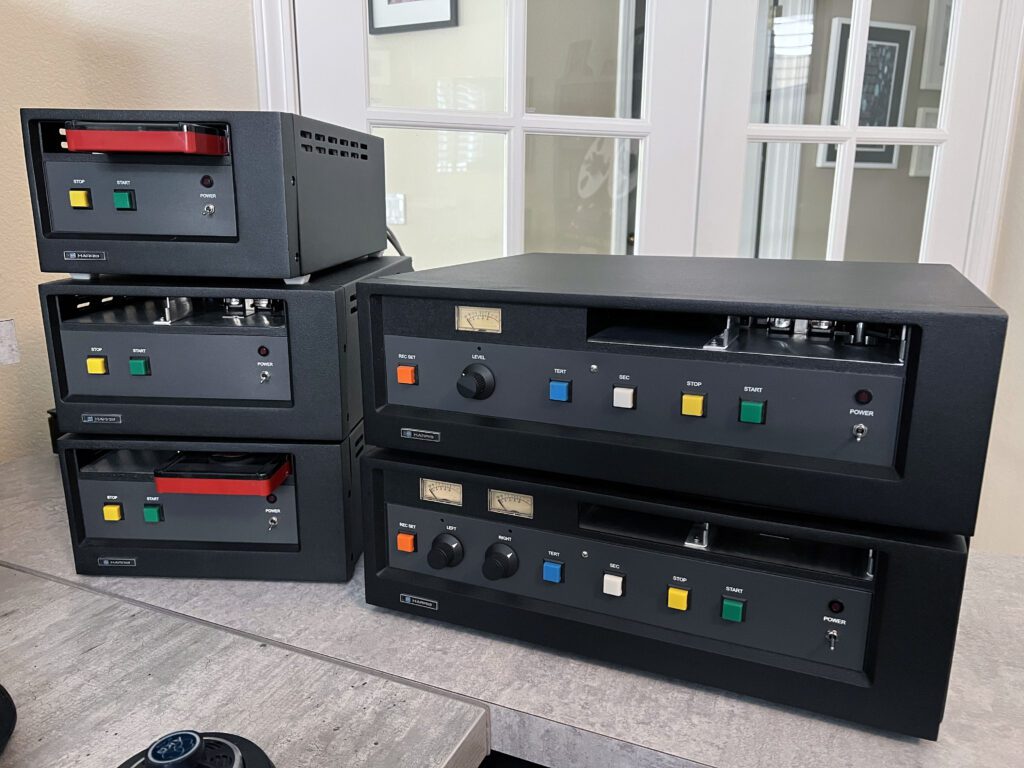
All five machines were disassembled, thoroughly cleaned, and serviced as needed. The cabinet was broken down into individual pieces and refinished by a local powder-coat shop. The center trim piece for each machine was reproduced by Protocase, which I have used for most projects requiring sheet metal work.
It is clear that I departed from the original Harris color scheme, which was a beige cabinet and silver trim on the front panel. Frankly, I like this look much more, and it matches nicely with the rest of the gear in the studio.
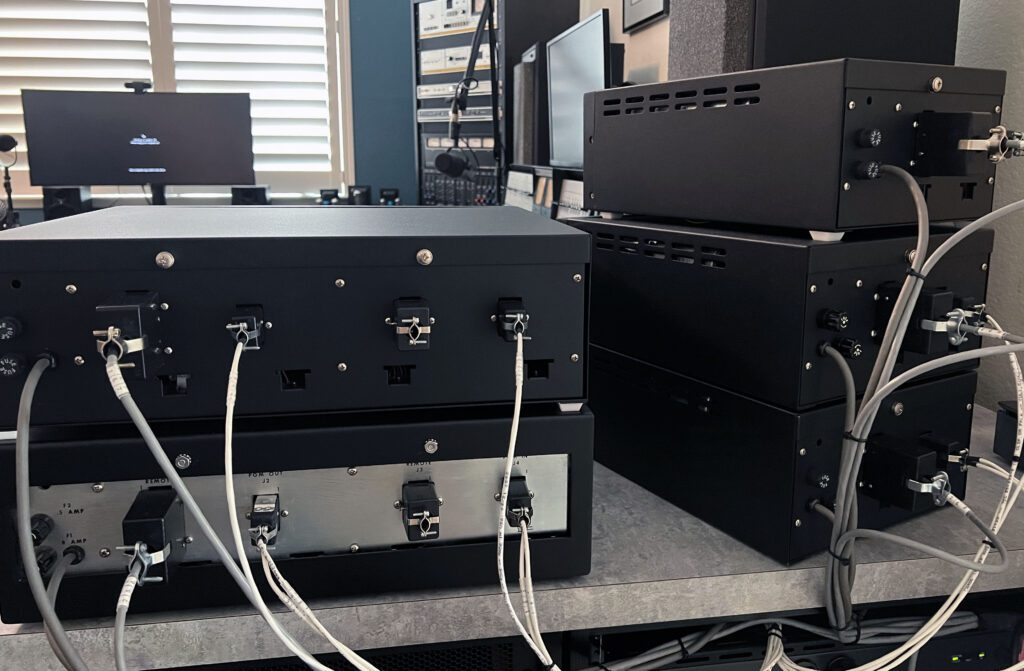
Most of the rear panels were refinished as well, providing a very clean overall look.
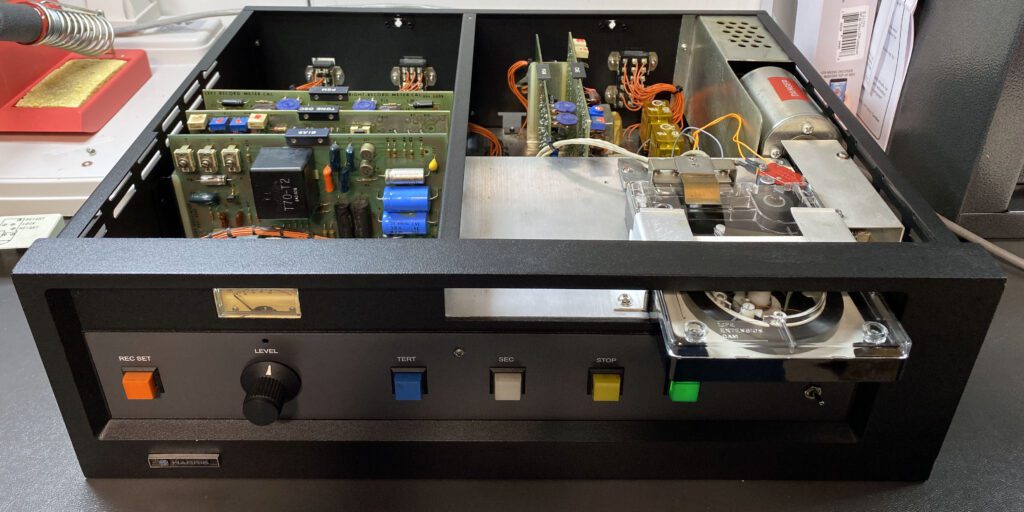
The cart machines cleaned up very nicely, as shown above. In order to get this level of restoration, it was necessary to disassembly the entire machine. The deck plate was stripped or all pieces except for the capstan roller. The front panel was likewise stripped and all switches removed. It was a major project, but the only way to return the cart machines to like-new condition.
One difficult aspect of the Criterion 90 cart machine rebuild project was dealing with tape head wear. The tape heads for most of the machines were in good condition. A couple, however, were worn the point of diminished performance, notably reduced high frequency response. Finding replacement heads is a very difficult proposition. Through a couple of good finds on eBay, however, I was able to replace the defective devices.
For the record, the Criterion 90 cart machine uses the following tape heads:
- Playback head: Nortronics P-B3Q6K-N (distributor equivalent stock #5707), dc resistance = 450 ohms
- Record head: Nortronics P-B3Q4R-N (distributor equivalent stock #5703), dc resistance = 260 ohms
A web search turned up a very useful document, “Nortronics Master File of Catalogued Tape Heads.” This document is useful not just for cart machine heads, but other machines as well.
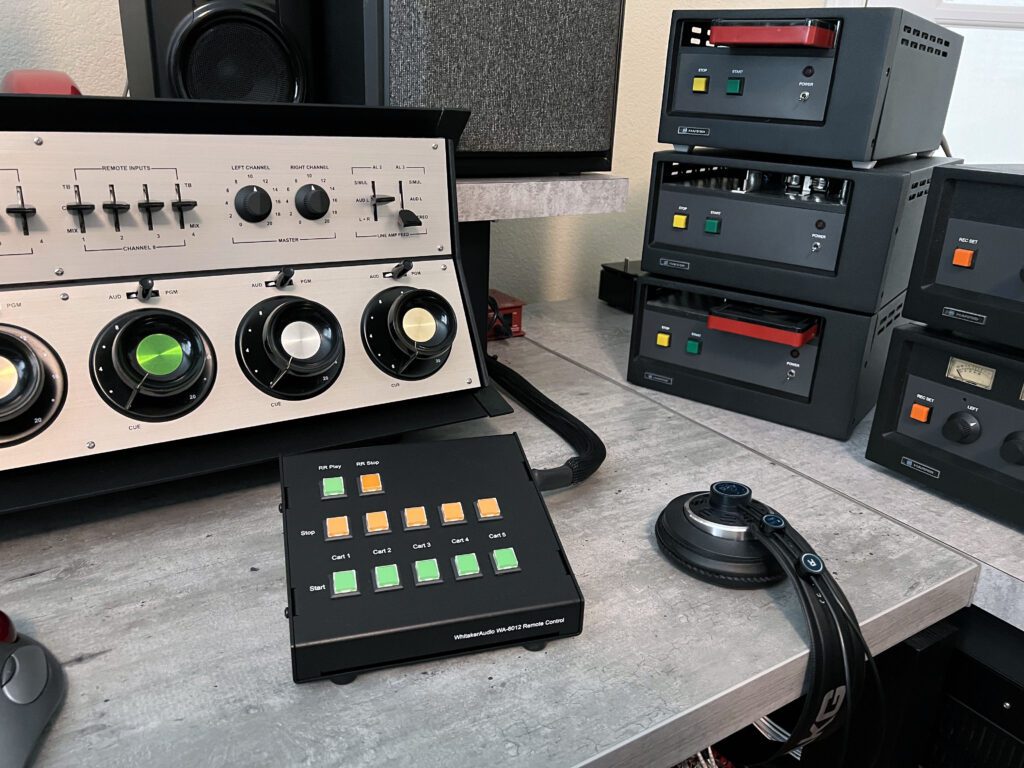
A remote control box was built to provide easy access to the Start and Stop functions. The pushbutton switches are illuminated and mirror the indications on the cart machines. Remote control is provided for all five cart decks, plus Start and Stop functions for the Ampex AG-440 reel-to-reel tape deck. The cabinet for the remote control box was produced by ProtoCase.
After a few weeks of use it became apparent that some of the machines did not pull tape consistently at the proper speed. The issue was traced to the pinch-rollers, all of which were at least 40 years old. Increasing the pinch-roller pressure was a poor solution since it didn’t solve the actual problem, which was rollers that had hardened and in some cases cracked. For a permanent fix, I contracted with ABBA Roller of Ontario, CA, to manufacture replacement rollers. ABBA is a specialty firm that manufactures custom and semi-custom devices within very tight tolerances.
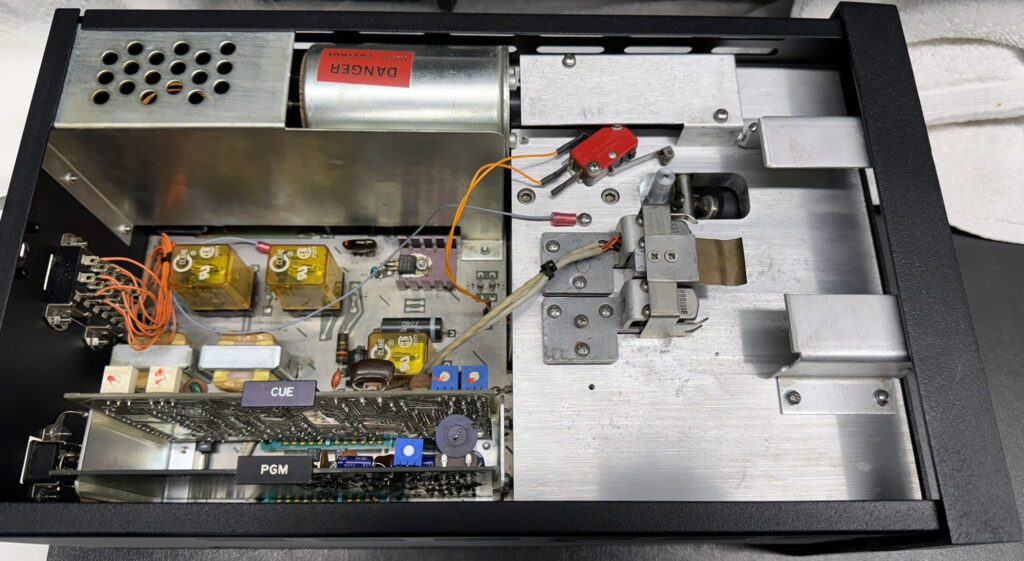
The new pinch-rollers came out great. A perfect fit. In a fortunate coincidence, the pinch-roller for the Criterion cart machine is identical to the pinch-roller used in the ITC RP and PD-II cart machines, and the SMC Carousel cart machine. I ordered a quantity of 10 replacement rollers from ABBA, which allowed me to update all machines in my inventory.
The replacement rollers were not inexpensive—about $100 each for a quantity of 10 ($1k total). Still, it is a permanent solution to a problem that was otherwise not easily addressed.
Harris CB1201 Turntable
This turntable was a great find on eBay. Even better, I was able to find two. In both cases, the tone arm was missing, but I was able to locate new-old-stock (NOS) Shure tone arms and cartridges.
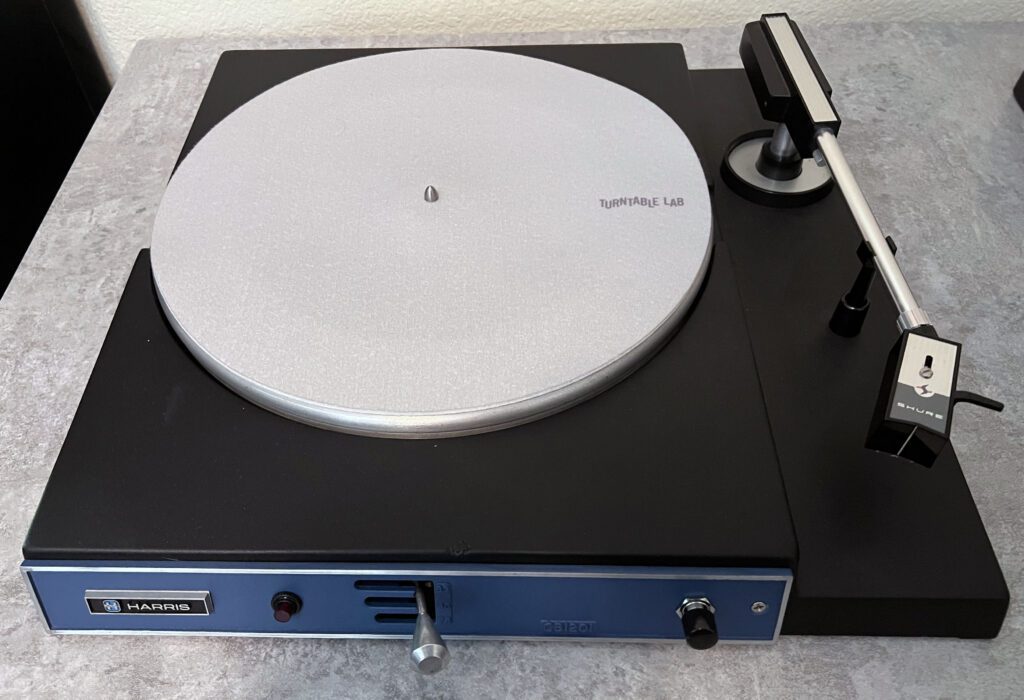
The turntable was completely disassembled for cleaning and refinishing. The base and blue trim plate were refinished by the local powder-coat vendor. This is another case where I deviated from the original Harris color scheme, in which the turntable base was beige. I like the black textured satin finish much more and it matches the color scheme of other equipment in the studio.

When the turntables were reassembled, I added a solid-state relay to provide for silent remote control.
This turntable, like many others of the time, uses an idler wheel to transfer rotational motion from the motor to the platter. Over time, the wheel can harden and develop cracks. This can result in increased wow and flutter, and the transfer of vibration from the motor to the platter. The solution is to replace the idler wheel. This is not a minor undertaking, however, since these devices have not been produced in decades. Even new-old-stock devices (if they could be found) would be inadequate since they have aged regardless of whether they were ever placed in service. The solution was to have custom replacements made.
To address the need for new idler wheels, Abba Roller was contracted to manufacture exact replacement devices. One such device is shown below.
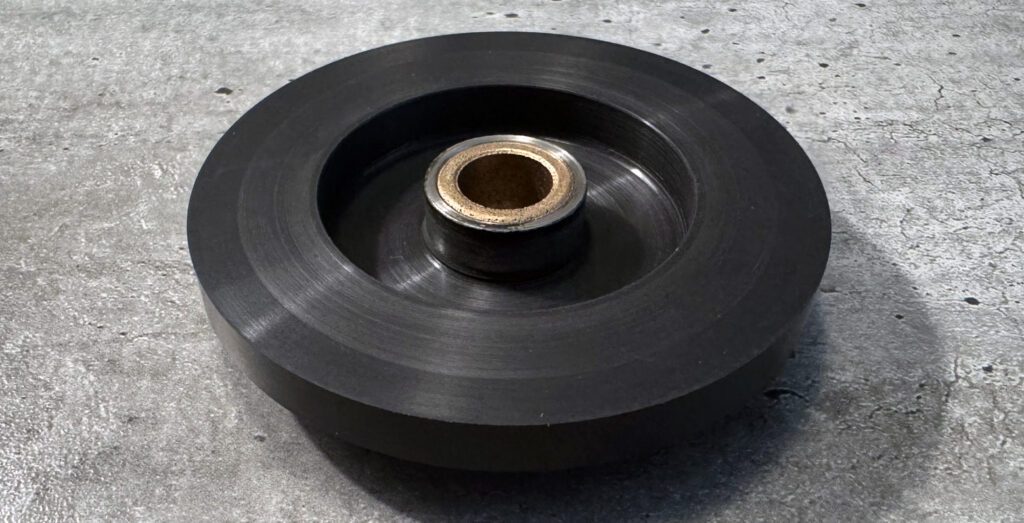
The new idler wheel fit perfectly and returned the Harris CB1201 to new condition.
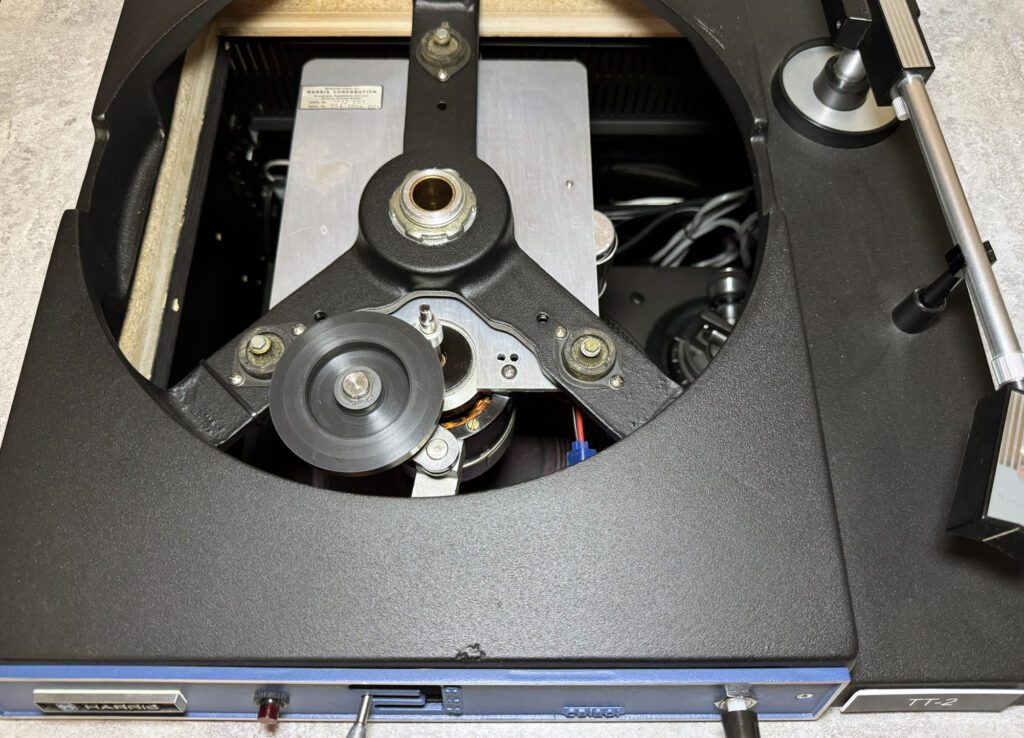
With a new felt cover on the platter, slip-cueing is easy.
Harris MSP100 Audio Processor
This is a beautiful piece of equipment. I installed one back in 1980 at the FM station I built. It is a very versatile device, and quite innovative for its time.
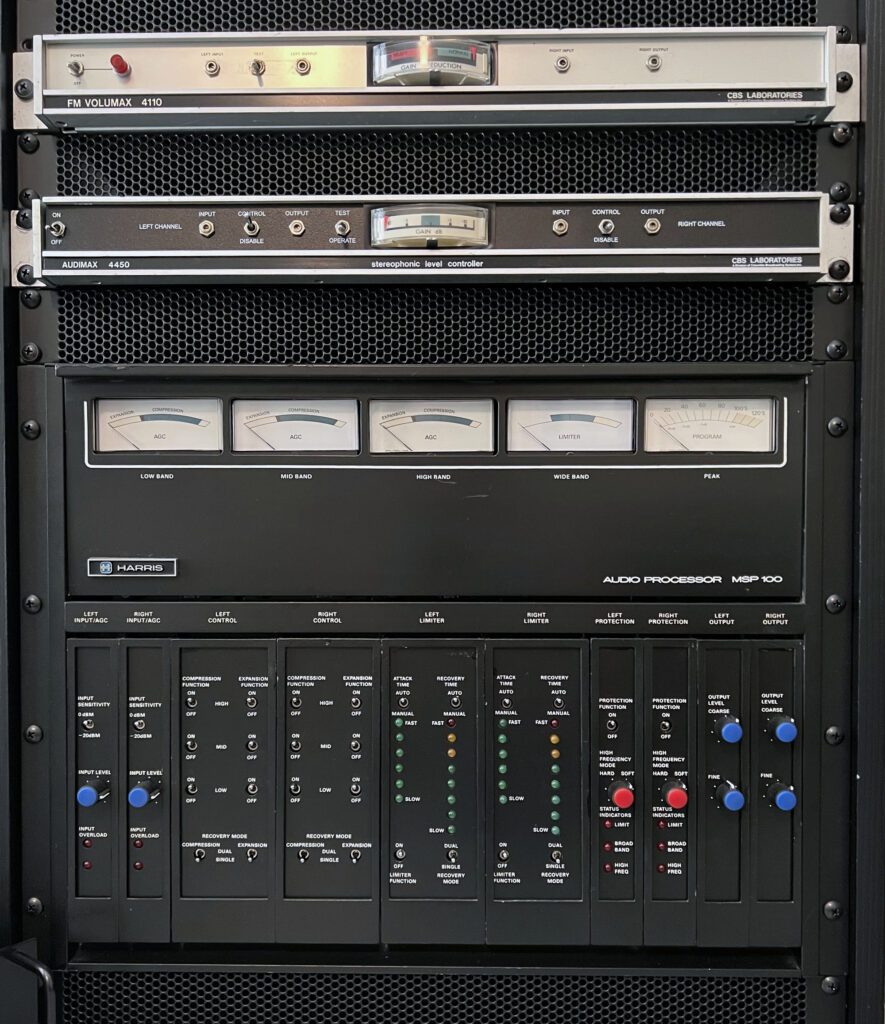
The restoration work on this device was a challenge. Old timers (such as myself) will remember that the MSP100 had long bat-handle switches on the front panel to control the audio processing functions. The switch handle colors were grouped by function. It was a very attractive and intuitive arrangement.
Unfortunately, the long switch handles were easily damaged. Of the two units that I purchased on eBay (one is used in the program chain and the other is a standby unit) nearly every switch was damaged. Despite an extensive search for exact replacement switches, I was unable to match the originals. So, I went with a convention PC-mount toggle switch, which probably should have been used in the first place considering how fragile the original configuration was.
Other work on the MSP100 included a through cleaning, replacement of a number of tantalum capacitors, and refinishing the cabinet.
The MSP100 is a joy to watch while operating. It has more meters and blinking lights than anything else in the studio!
Above the MSP100 you can see the CBS Audimax and Volumax. Very nice audio processing gear.
Classic Western Electric Telephone
Every studio needs a phone—red if possible.
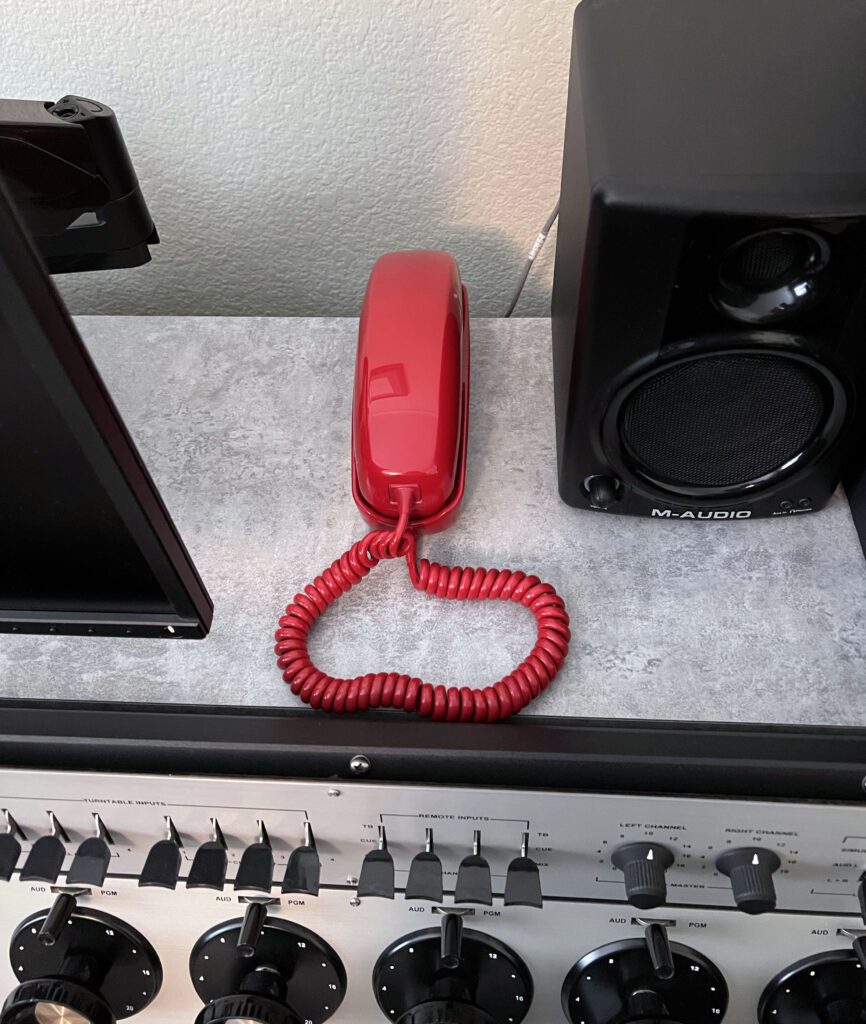
I found this old-school telephone on eBay and couldn’t resist. The phone connects to the Gentner phone patch. Unfortunately, the phone patch does not connect to a real (analog) phone line because there is none available anymore to connect to. Still, it’s a cool piece of history.
There are two phones—one in the studio and another at the transmission equipment rack. The studio device is touch tone and the transmission rack device is rotary dial.
TFT FM Monitors
I have a fondness for TFT monitoring gear, having installed a number of them at the FM station I built in the late 1970s. Restoring most of the equipment was relatively easy, except for the FM monitor and preselector.
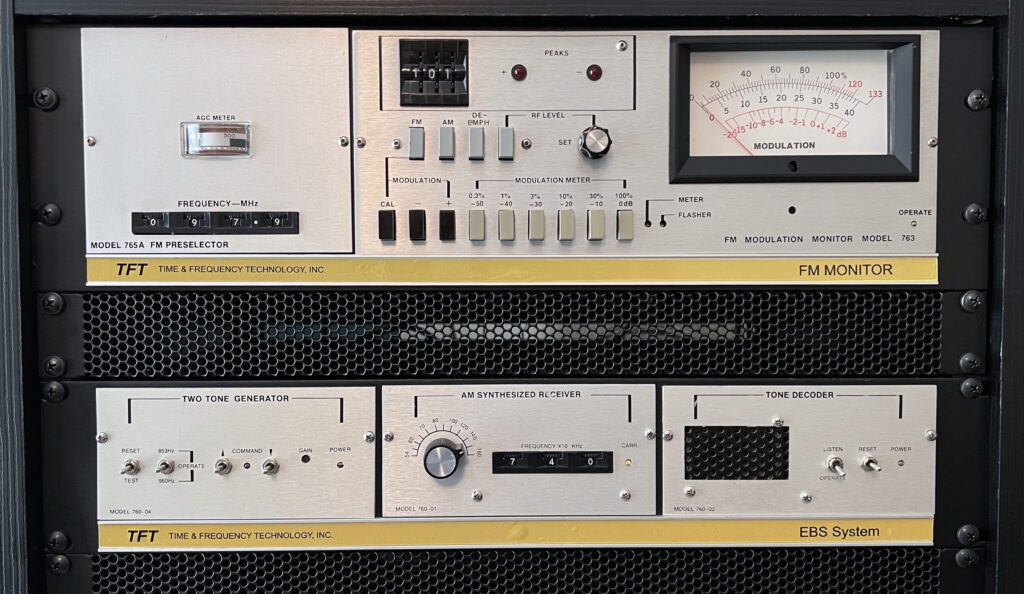
I have two FM monitors. Both required work to return to a serviceable condition. The greatest challenge was with with the preselector modules. Essentially an FM tuner, getting these instruments to work correctly was a bit of a challenge. But I got there eventually.
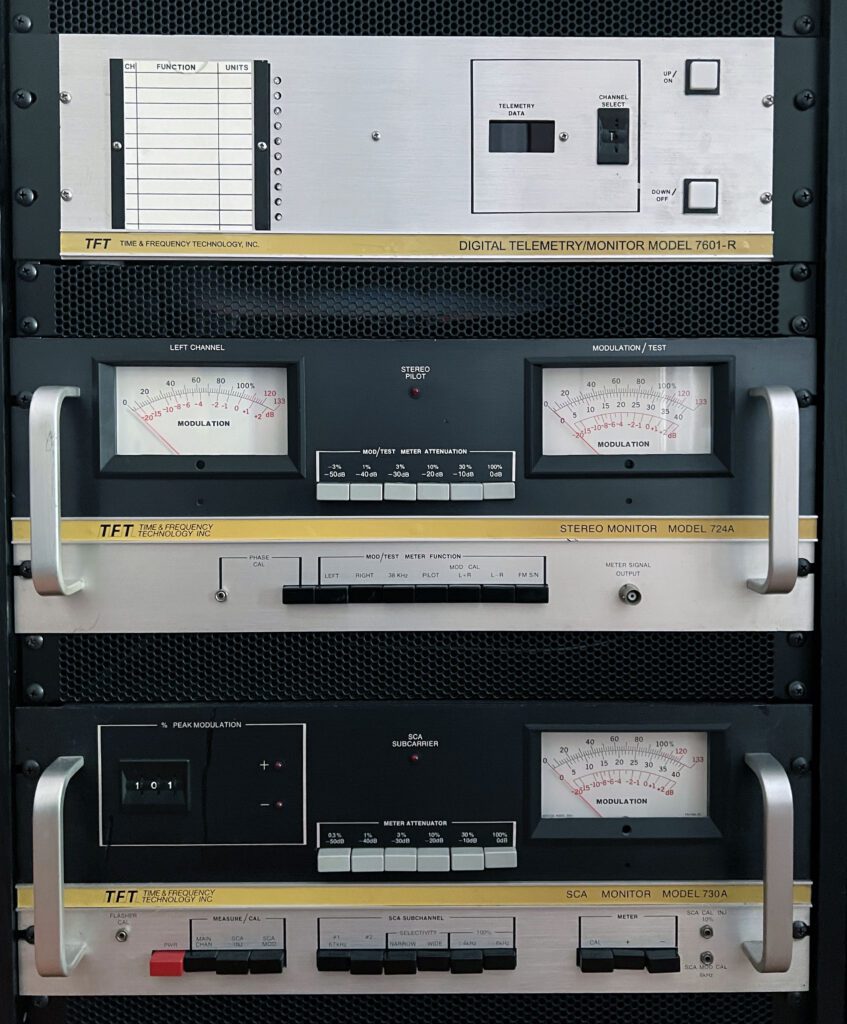
The TFT 724A stereo monitor and 730A SCA monitor are fed from the FM monitor. These units tuned up to specifications without trouble. The TFT 7601, shown at the top of the rack above, took some work to return to service, but it was worth the effort. With the remote control connected at the “studio” and “transmitter” locations, control of the FM exciter is possible, effectively serving as a transmitter remote on/off system.
Collins 310Z-2 FM Exciter
The Collins exciter serves as the “transmitter” for the 1970s studio project. The 310Z-2 was another eBay purchase. It arrived in relatively poor shape, with so many issues that I considered dropping the project altogether. However, I kept working on it—with very satisfactory results. The front panel was damaged and the decision was made to remake the entire panel, including the card cage cover.
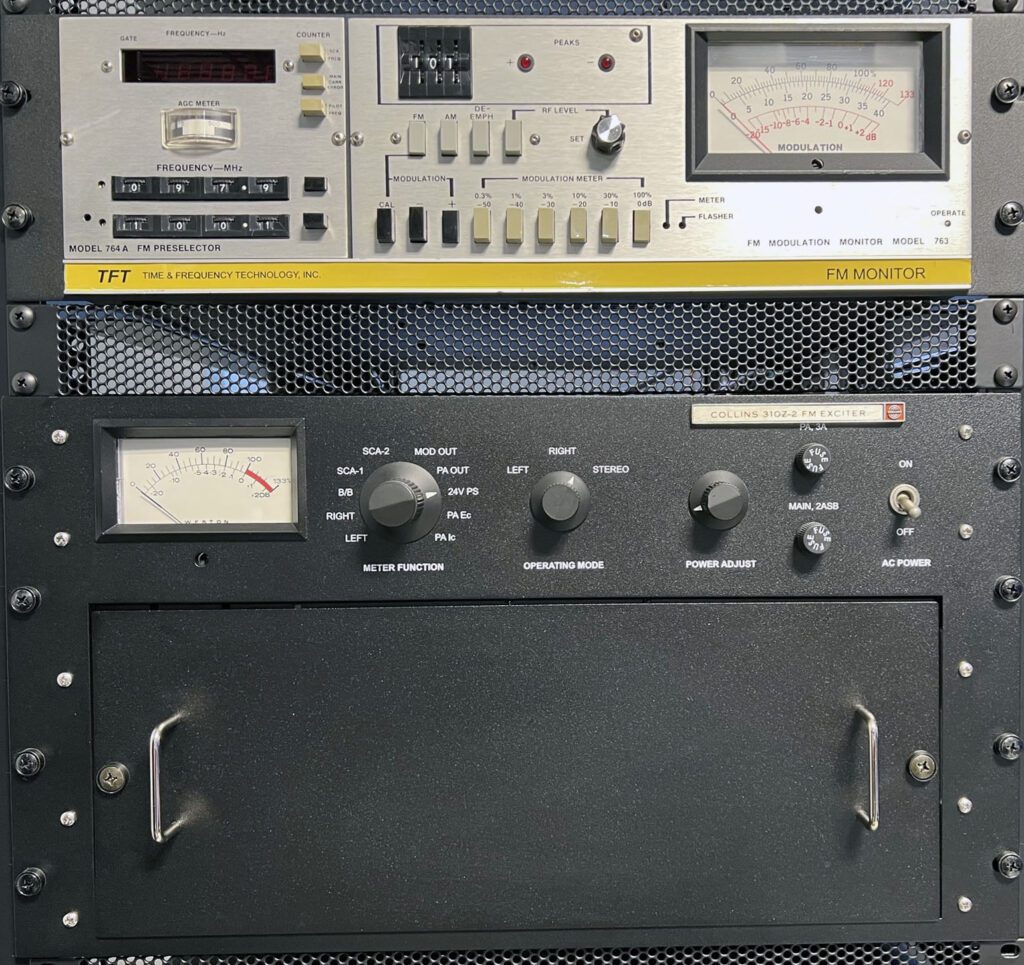
The output of the exciter is connected to a dummy load through an RF sampling device that provides input to the TFT FM monitor. Alternatively, the output can be connected to a 1/4-wave antenna mounted outside the workroom for on-air tests at very low power. The 310Z-2 can be adjusted down to about 2.5 W output. The maximum output of the exciter is about 22.5 W.
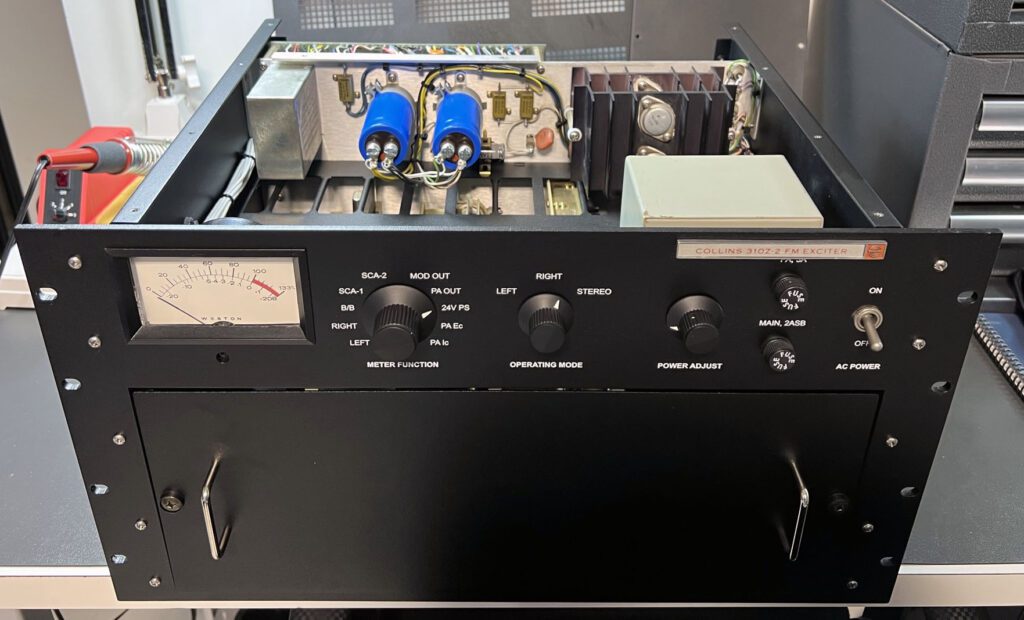
The photo above shows the 310Z-2 on the bench undergoing performance tests.

The exciter RF output can be enabled or disabled by applying a voltage to the appropriate terminal on the interface panel. The TFT 7601 is used to provide that control voltage, thus enabling “transmitter on/off” control from the studio. Cat-5 cabling is used to connect the 7601 control and remote units using the “telco” service lines.
A voltage sample is also taken from the 310Z-2 and applied to the 7601 for telemetry.
Moseley PCL-505 STL
Two Moseley PCL-505 STL transmitters were acquired on eBay. Both were functional, but the front panels were rather beat up. More importantly, the meter selection switches on both units were intermittent (at best).
As built, the input to the PCL-505 front panel meter is controlled by a bank of 10 interlocking push-button switches. This approach, very much in favor during the late 1970s and early 1980s, provided an intuitive and compact way to switch among a number of inputs. While this type of switching system worked well initially, over time the switches tended to develop reliability issues.
For every switch position, the signal path from the input source to the front panel meter passes through multiple contact pairs. For example, when the AFC switch is depressed, the signal to the positive meter connection passes through 8 switch pairs and the signal to the negative meter connection passes through 10 switch pairs. Thus, in order for the AFC meter reading to be displayed, 18 switch pairs must perform properly.
Since repair of these switch assemblies is problematic and no replacements could be found, the decision was made to instead install a single 3-pole 10-position rotary switch. This approach greatly simplified the path from the signal source to the meter. For all cases except for PROG and MPX, only two switch pairs are involved. For PROG and MPX, three switch pairs are involved.
This change, however, necessitated production of a new front panel, as shown below.
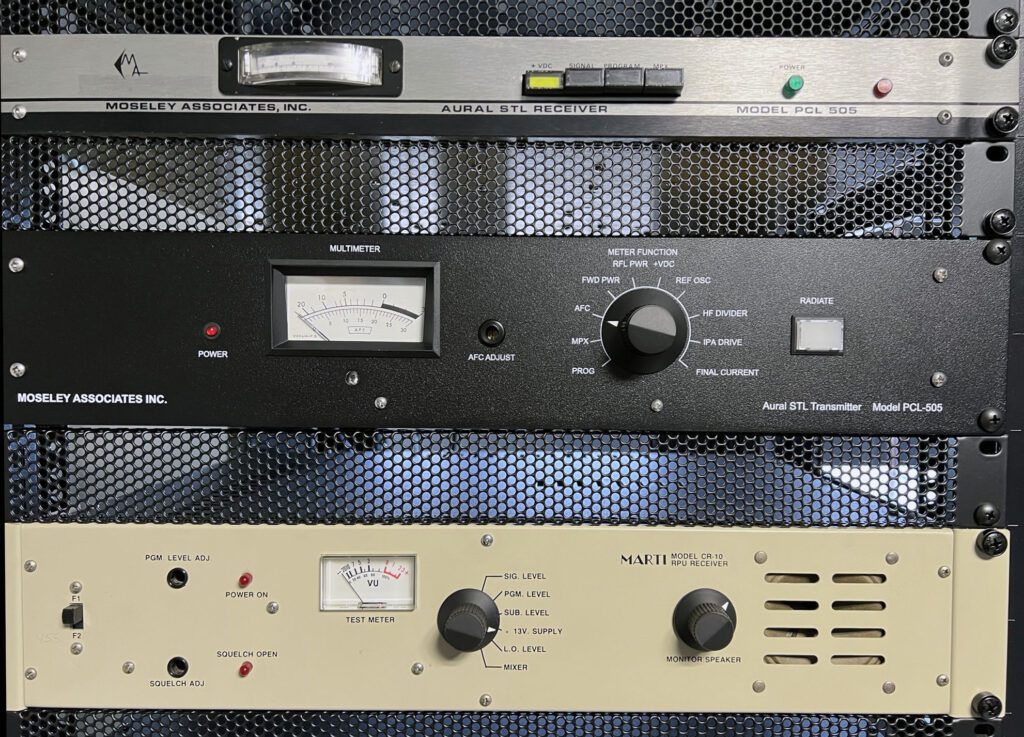
No attempt was made to duplicate the color scheme of the original front panel, instead going to a style that matched the other remanufactured panels in the 1970s studio.
The RADIATE switch on the PCL-505 was also replaced on both units. That switch was also a mechanical push-button device that was broken on one of the transmitters. It was replaced with a new lighted push-button switch. The lamp is driven from the V+ supply to the output amplifier. In this way, the lamp is illuminated when the unit is transmitting. The original switch used a mechanical drop-down colored insert to show when activated (whether the transmitter was working or not).
The PCL-505 receiver, which can be seen at the top of the photo above, has a similar but smaller push-button assembly. It is not completely reliable but the size limitation of the front panel prohibits replacement of the original switch with a new rotary device
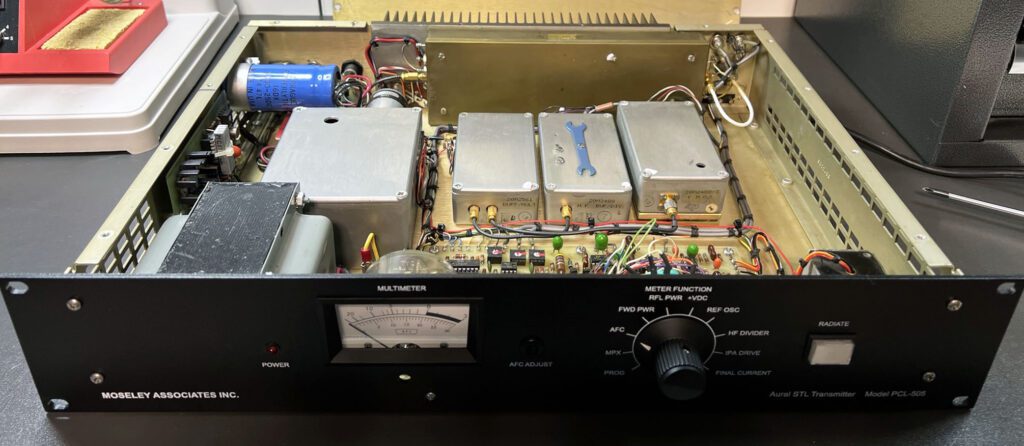
The PCL-505 transmitter is shown above on the workbench undergoing final tests.
Marti RPU Transmitter
The Marti Electronics RPT-15 remote pickup transmitter was a popular device back in the day for doing remote broadcasts. At 15 W rated output, and with a good directional antenna, considerable distances could be covered. I found this unit on eBay, and other than refinishing the cabinet, no service was required. It worked out of the box.
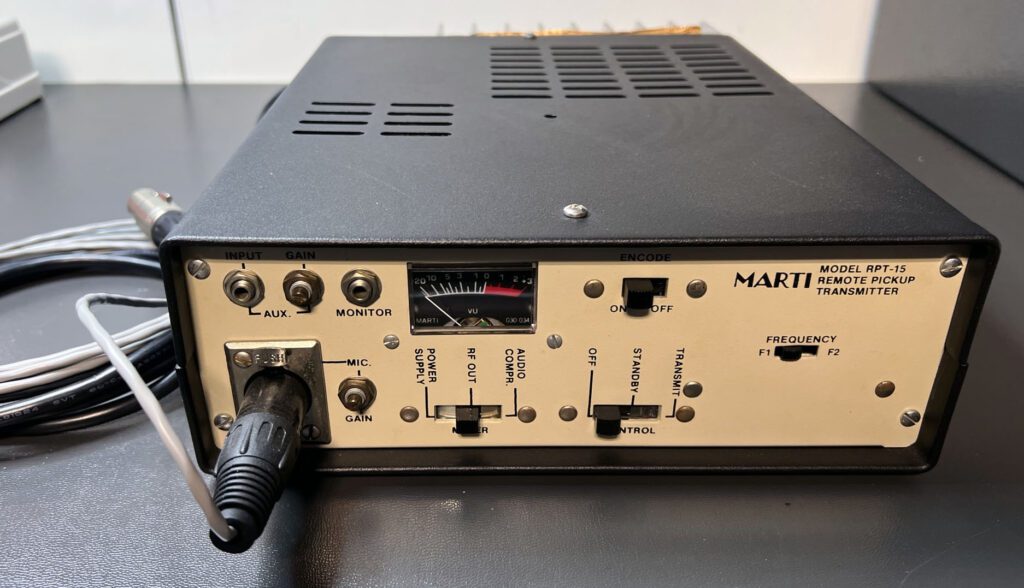
The companion receiver, the Marti CR-10, can be seen in the “Moseley PCL-505 STL” entry above. The two units were purchased separately on eBay, and unfortunately they operate on different frequencies. The search is on for matching crystals, but that’s probably a long shot at this point. In any event, each unit works…just not with each other.
Downloads are available for some of the projects described here. See the Available Downloads blog for details.

At this writing, the 1970s radio studio is essentially complete. The only thing missing is a high-power transmitter. I’m working on that. Step 1: find a unit on eBay. Step 2: find room for it…